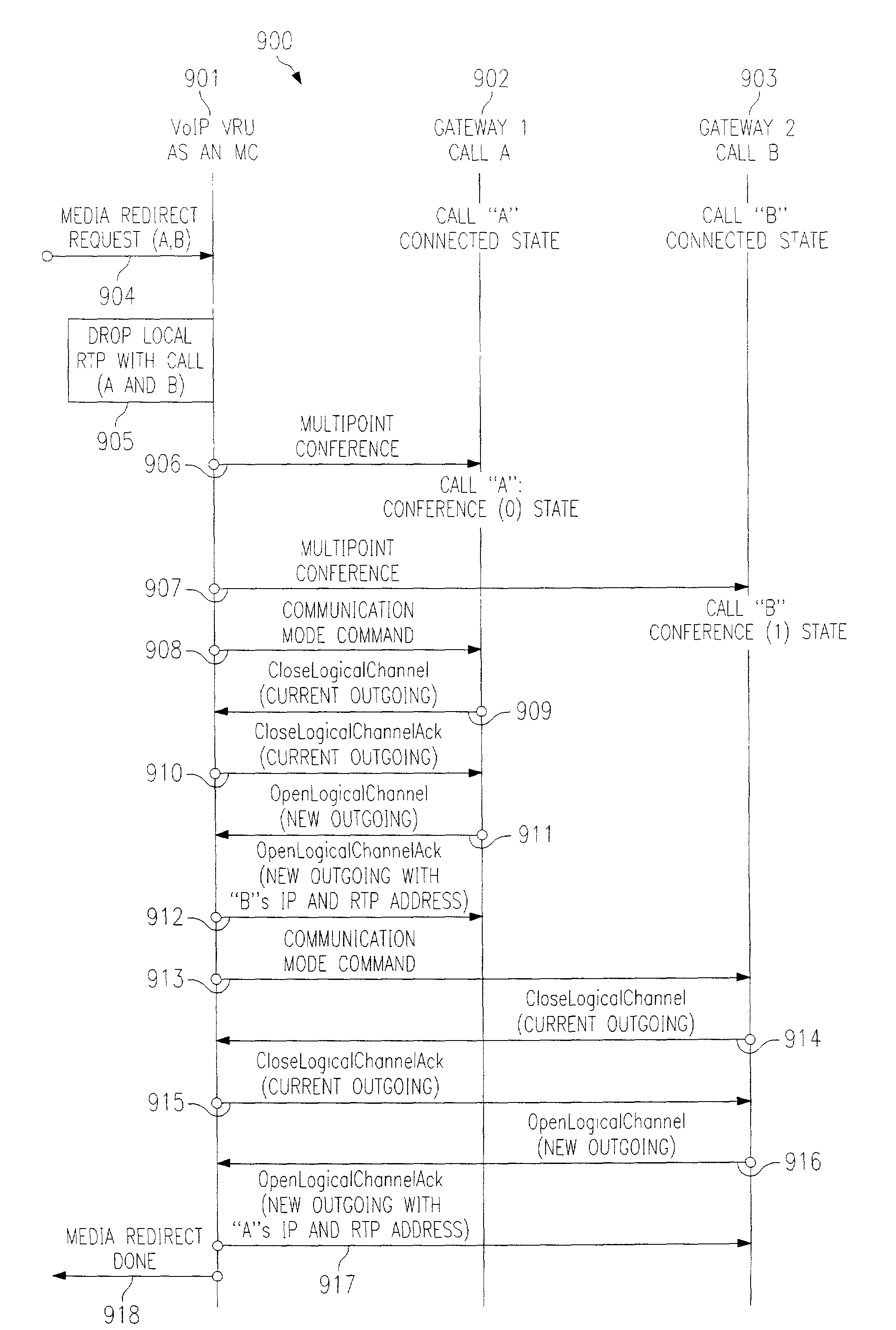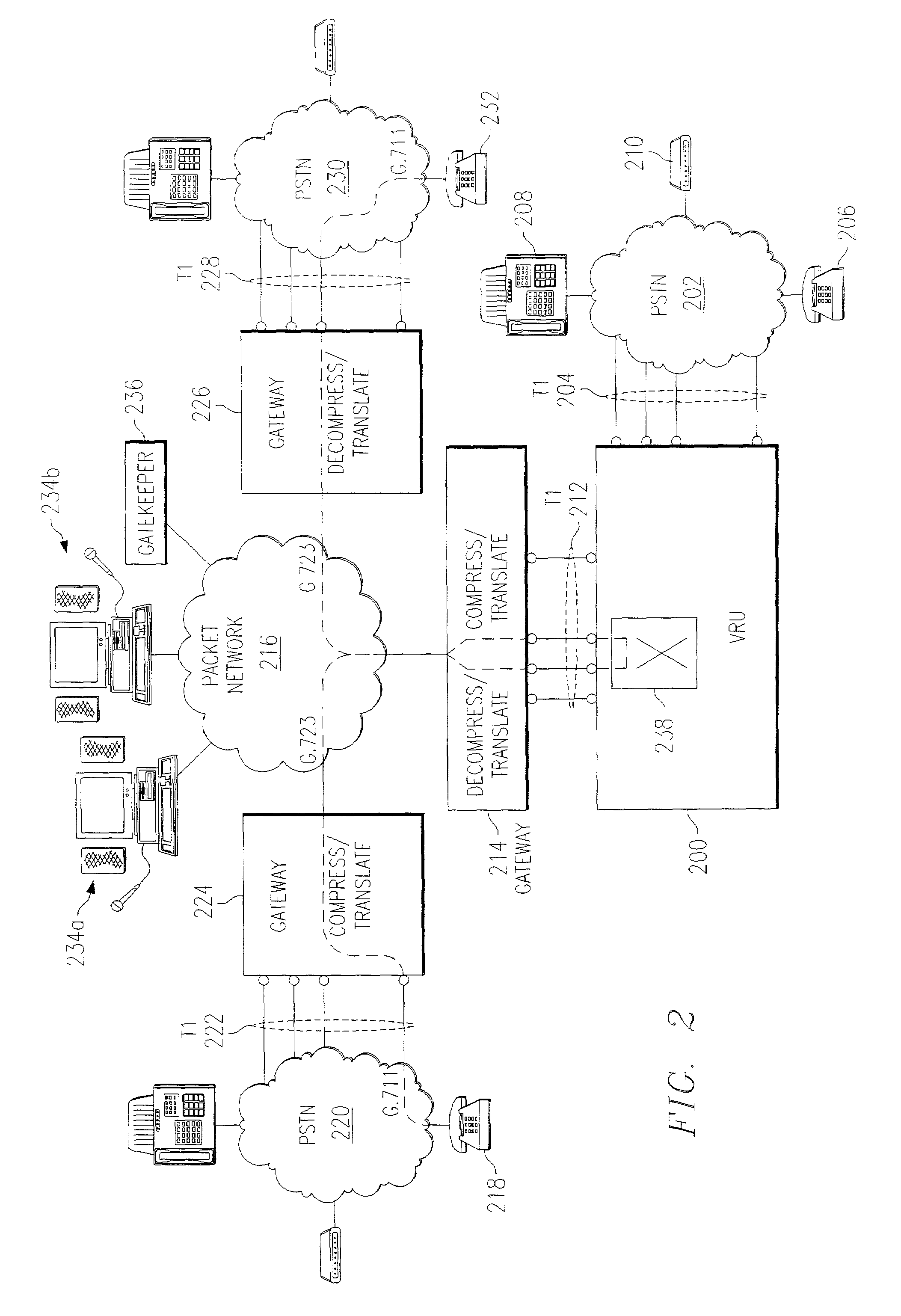[0041]Accordingly, it should be appreciated that an advantage of the present invention is that call control is not limited to a single controller device, and may in fact be distributed to a plurality of network devices. A further advantage of the present invention is that there is no requirement that the network itself operate to control a call, such as is the case with the switches of the PSTN, but instead nodes coupled to the network, whether one or more, operate to control the calls and provided enhanced calling services.
[0042]An advantage of a preferred embodiment of the present invention is that a media controller, such as provided by a packet VRU of the present invention, may generally provide the existing enhanced services of a synchronous VRU, but in a packet network environment. Another advantage of a preferred embodiment of the present invention is that a packet VRU may provide enhanced services for multimedia communications in addition to voice-only communications. Because of the added multimedia functionality, a packet VRU may also be described as a packet Multimedia Response Unit (“MRU”), or a packet Interactive Multimedia Response (“IMR”) Unit. All such systems may also be referred to as the aforementioned packet Enhanced Service Provider (“ESP”). Of course, with the added multimedia functionality, new enhanced services, such as video conferencing, shared whiteboarding and text chatting, which were not implemented in voice-only communications, will become desirable, and all such enhanced services are intended to be within the scope of the present invention.
[0043]A further advantage of a preferred embodiment of the present invention is that repeated conversions from one data format to another data format are avoided because the media is sent directly from source to destination, and not through a centralized media control system, such as a VRU. In addition, because the media control system of the present invention is implemented as a core device within the packet network instead of as an edge device, the media control system does not need to provide multiple device-type access such as for modems and fax machines. Instead, gateways may direct only the voice calls to particular aspects of the media control system, such as a packet VRU, and direct fax and modem calls elsewhere. Also, the media control system may not need to provide data format conversion between the packet network and another type of network, such as a switched network, although connecting a combined packet / synchronous VRU to both types of networks may still be desirable for some applications.
[0044]A further advantage of a preferred embodiment of the present invention is that a packet network interface generally does not require multiple physical ports and an internal switch for connecting more than one party together for enhanced services such as calling card and one-number services. Instead, any switching / routing is handled in the packet network itself. A single packet network interface may handle all traffic with the media control system. For example, a single 100 Mbit Ethernet interface may carry over 10,000 5 Kbit G.723 compressed voice channels plus overhead. Alternatively, more than one packet network interface may be implemented. In addition, multiple parties may be connected by redirecting the media streams to travel directly between the parties, without passing through the media control system. Thus the media control system may avoid the delays associated with an internal jitter buffer, internal processing of the packets, and separate media streams from the media control system to each party.
[0045]A further advantage of a preferred embodiment of the present invention is that a media control system of the present invention, such as a packet VRU, may redirect the media streams and still retain control of the call by keeping the call states between the parties and the media control system intact. Redirecting the media streams may free up valuable resources in the network devices, such as a packet VRU, such as voice recognition resources, so that they can be used to handle other calls. In addition, the media control system may still receive user input indication messages. This embodiment has a further advantage over a synchronous VRU in that it can perform a function similar to RLT in the PSTN, discussed above, but still monitor for user input indication signals and still keep track of the call context. Thus the media control system, and not the network, would monitor for user input indication signals. For example, if a packet VRU redirects a calling card caller's call from a third party to the VRU in response to a user input indication message, the calling card caller would not have to re-enter Card Number and PIN information to make a second calling card call.
[0046]Yet another advantage of a preferred embodiment of the present invention is that generally only the amount of bandwidth needed is used in the packet network interface (and throughout the packet network), instead of the 64 Kbps channels generally required for each connection in a switched network.
 Login to View More
Login to View More  Login to View More
Login to View More 


